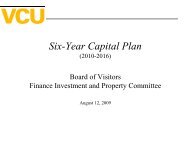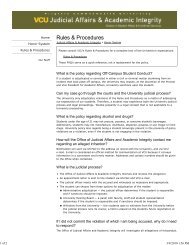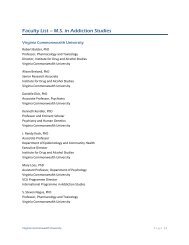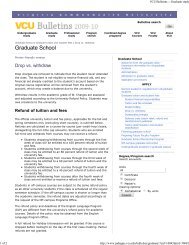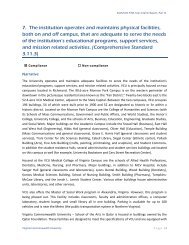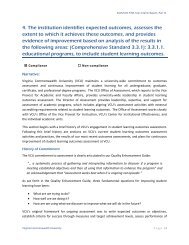Part V of the Fifth-Year Interim Report - VCU SACS/COC Tenth Year ...
Part V of the Fifth-Year Interim Report - VCU SACS/COC Tenth Year ...
Part V of the Fifth-Year Interim Report - VCU SACS/COC Tenth Year ...
Create successful ePaper yourself
Turn your PDF publications into a flip-book with our unique Google optimized e-Paper software.
<strong>SACS</strong>/<strong>COC</strong> <strong>Fifth</strong>-<strong>Year</strong> <strong>Interim</strong> <strong>Report</strong>, <strong>Part</strong> V<br />
First-year retention<br />
Below are <strong>VCU</strong>’s first year retention rates for Fall 2006 to Fall 2009.<br />
Fall 2006 82.3%<br />
Fall 2007 82.7%<br />
Fall 2008 84.2%<br />
Fall 2009 83.4%<br />
Several important factors related to freshman retention have been used to evaluate improvements since <strong>the</strong> Focused<br />
Inquiry program has been implemented. First is a comparison <strong>of</strong> <strong>the</strong> DFW rates from <strong>the</strong> English 101 course during <strong>the</strong><br />
time period from fall 2003 to spring 2006. During this three-year period, <strong>the</strong> DFW rates averaged 27.5%, with a high <strong>of</strong><br />
33% and a low <strong>of</strong> 20%. Rates from <strong>the</strong> 2006-07 academic year were not used in this analysis because both English 101<br />
and a piloted version <strong>of</strong> <strong>the</strong> Focused Inquiry courses were <strong>of</strong>fered simultaneously. In <strong>the</strong> 2007-09 academic years,<br />
Focused Inquiry had replaced English 101 as a required general education course. The DFW rates during both <strong>the</strong> fall and<br />
spring semesters averaged 12% across all course <strong>of</strong>ferings in 2007-2008 while falling to 10% and 6.6% in <strong>the</strong> 2008-2009<br />
year. The Focused Inquiry program was successful in keeping <strong>the</strong> DFW rates relatively lower and was able to maintain<br />
stability in those rates over both <strong>the</strong> fall and spring semesters.<br />
Academic standing among freshman is directly related to <strong>the</strong> success rates <strong>of</strong> freshman enrolled in <strong>the</strong> required general<br />
education courses such as Focused Inquiry. Generally speaking, retention will be higher when more students are in good<br />
academic standing with <strong>the</strong> institution. The number <strong>of</strong> freshman students in good academic standing at <strong>the</strong> end <strong>of</strong> <strong>the</strong> fall<br />
and spring semesters for <strong>the</strong> past five academic years has been improving. As is expected with lower DFW rates and<br />
higher levels <strong>of</strong> student engagement in <strong>the</strong> classroom (as will be illustrated later in this report), more freshman students<br />
were in good academic standing at <strong>the</strong> end <strong>of</strong> both <strong>the</strong>ir first semester and <strong>the</strong>ir first full year <strong>of</strong> college than in <strong>the</strong><br />
previous five years.<br />
The percentage <strong>of</strong> first-year students choosing to reenroll at <strong>VCU</strong> after completing <strong>the</strong>ir first full year <strong>of</strong> college has<br />
gradually been on <strong>the</strong> rise for <strong>the</strong> past eight years. The first-year retention rate for <strong>the</strong> 2006-2007 academic year at <strong>VCU</strong>’s<br />
peer institution averaged 82% with a high <strong>of</strong> 95% at <strong>the</strong> University <strong>of</strong> Sou<strong>the</strong>rn California and a low <strong>of</strong> 73% at both Wayne<br />
State University and <strong>the</strong> University <strong>of</strong> Utah. However, a significant increase in freshman retention at <strong>VCU</strong> is evidenced<br />
during <strong>the</strong> past three academic years after <strong>the</strong> implementation <strong>of</strong> both University College and <strong>the</strong> Focused Inquiry<br />
program.<br />
NSSE and CLASSE target data for freshman<br />
A number <strong>of</strong> NSSE items were targeted as possible areas where <strong>the</strong> Focused Inquiry curriculum could help improve<br />
student engagement. These areas deal with classroom engagement, collaborative work with o<strong>the</strong>r students, writing<br />
goals, and faculty/student interactions. The results from <strong>the</strong> 2006-07 and 2007-2008 NSSE results are compared to<br />
matching items on <strong>the</strong> CLASSE which was administered in each Focused Inquiry course during both <strong>the</strong> spring semesters.<br />
The Focused Inquiry curriculum brought about significant results regarding <strong>the</strong> number <strong>of</strong> students that actively engaged<br />
in classroom presentations and collaborative work with o<strong>the</strong>r students during class time. The only category where change<br />
was not indicated is in <strong>the</strong> use <strong>of</strong> electronic mediums for discussing or completing class assignments.<br />
In <strong>the</strong> area <strong>of</strong> student engagement in a classroom setting, significant improvements are indicated by <strong>the</strong> CLASSE. Over<br />
75% <strong>of</strong> first-year students during those fall and spring semesters indicated that <strong>the</strong>y participated in class discussions in<br />
<strong>the</strong>ir Focused Inquiry course <strong>of</strong>ten or very <strong>of</strong>ten. Similarly, significant increases in <strong>the</strong> numbers <strong>of</strong> students asking<br />
questions during class are indicated.<br />
An additional goal <strong>of</strong> <strong>the</strong> Focused Inquiry curriculum was to increase students’ experiences with higher order thinking<br />
skills, such as analyzing, syn<strong>the</strong>sizing, and evaluating information in <strong>the</strong> classroom and on assignments outside <strong>the</strong><br />
classroom. Both <strong>the</strong> NSSE and CLASSE contain items related to <strong>the</strong> frequency <strong>of</strong> engagement in <strong>the</strong>se processes. Once<br />
Virginia Commonwealth University P a g e | 8



